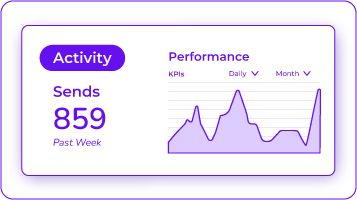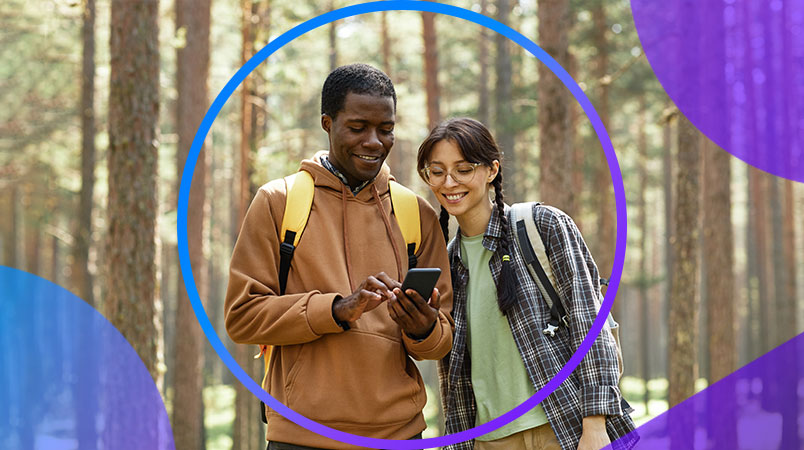
Increase relevance and revenue with personalization at every touchpoint
Easily consolidate exsiting data platforms and remove redundant tools.
Empower employees to access and understand customer data all in one place.
Leverage your own data sources to build a rich understanding of each customer, decreasing dependence on 3rd party cookies. Our Customer Data Platform unifies data across all touchpoints into real-time 360-degree customer profiles, enabling you to nurture strong relationships and drive revenue.
Monitor visitors browsing patterns and merge with the relevant profile when possible.
Integrate first-party data no matter where it’s stored, eliminating dependence on cookies.
Accurately identify and merge data from the same individual into 360° customer profiles.
Enhance customer profiles with AI-driven recommendations, such as predicting behaviour, enabling customer service and marketing to provide truly personalized 1:1 interactions.
Request a demoConnect existing data sources and allow the AI to learn from the start and continuously with every interaction.
Fuel the algorithms with your own business specific context and adjust when necessary to ensure accurate, relevant predictions
Gain transparency and view insights into why certain AI-driven recommendations have been suggested.

Easily identify and segment customer profiles based on historical interactions and real-time behavior. With just a few clicks you can easily create data-driven audiences for every campaign.
Create, automate and activate campaigns based on customer behavior and triggers to reach your customers at the right time, with the right information and on the right channel.
Our Customer Data Platform seamlessly integrates with our service and marketing tools to create a unified customer experience and unify data across departments. It effortlessly connects to our Mobile Marketing Cloud, AI Decisioning Engine, Mobile Service Cloud and more.
Our Engagement Platform connects our Customer Data Platform with marketing to ensure all data is directly available to deliver personalized campaigns and tailored content.
Our Engagement Platform integrates our Customer Data Platform with customer service, providing all marketing and service data right next to the conversation, all in one screen.
Our Engagement Platform connects customer data with our chatbots to ensure personalized conversations and vice versa, extracts data from chatbots to the Customer Data Platform.
When we're building email campaigns we can access real-time data directly through the CM.com platform. We can then interrogate that data in terms of who we want to talk to, create a subsegment and tailor our communication to that group.
Iain Starkey, Marketing Manager
We want to be using CM.com’s platform as much as we can because it gives us more information about what our supporters and the people who are attending Sophia Gardens want and then we can set up their experience accordingly.
Ed Rice, Head of Commercial
With all stored information in the Customer Data Platform, the most complete, 360-degree view of the fan was created. Based on that data, Mobile Marketing Cloud gave the Dutch Grand Prix the opportunity to communicate with all fans in a personal, practical way.
Teun Verheij, Head of Marketing Communications

A CDP or Customer Data Platform is software that collects customer touchpoints and interactions with your product or service from various channels and sources. It aggregates all this data from multiple sources to create a unified profile of each customer.
Learn more
Cookieless data collection gathers user data and insights without using website cookies (data trackers that contain personal identifiers) either because the user rejects them or because they are not permitted. This method is growing given multiple tracking restrictions and privacy regulations.
First-party data is customer data collected with consent and owned directly by your company (the data controller). It is a valuable source of customer insight in the age of data privacy, as regulations and security measures now make other types of data less secure, accurate, and reliable.
Learn moreClient and server-side tracking are two routes to collecting audience data. With client-side tracking, the user’s browser (client) sends data to the tracking platform’s server. Server-side tracking sends the user data to your website server first before being transferred to the tracking platform.
Learn moreAs a member of the customer service team, you stand on the frontline of customer interaction every day. In a world where customers demand quick and personalized service, long wait times, impersonal responses, or worse, incorrect answers, can quickly drive a customer away. Your goal, however, is to connect customers with your organization and deliver the best answers and service possible.
What’s new in mobile marketing for 2022? While some recent trends in mobile marketing remain static, others continue to gain ground as marketers increasingly embrace mobile-first marketing strategies. In this article, we’ll share our predictions for the most impactful mobile marketing trends in 2022.
Along with a slate of new user features, Apple’s iOS 15 update promises significant changes to your email marketing strategy this fall. These include new privacy protections that will have a massive impact on key metrics, tracking, email list hygiene, and data collection. Learn more about what these iOS 15 changes will mean for your business and what you can do to prepare for them.
The real estate industry has been comparatively slow to pick up on the benefits of marketing technology and automation, although there are numerous elements of real estate management that are better handled by machine than human. So why the slow uptake?
The best marketers are always looking for ways to sharpen their marketing efforts and reach more customers. Discover how an effective customer segmentation strategy can increase customer engagement and boost ROI.
Data management platforms (DMPs), customer relationship management (CRM) systems and customer data platforms (CDPs) can all play an important part in the customer lifecycle, but telling the difference between them can get tricky. Let’s have a look at what they do, how they differ and what they can do for each business.
The ease of communication between businesses and consumers weighs heavily on customer service. Emerging technologies offer numerous possibilities to start conversations with your customers. Conversational channels such as WhatsApp and Facebook Messenger are increasingly being used by companies to engage with customers. But how can you use these channels? To get you up to speed, we share some proven examples. Get inspired and enhance your customer experience today.
Select a region to show relevant information. This may change the language.













